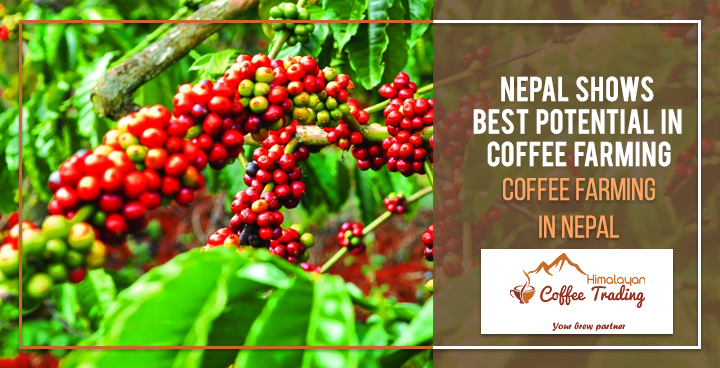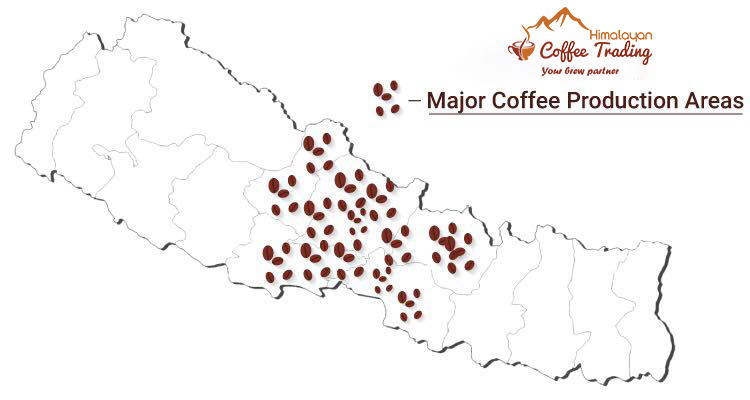Nepal is a country that is gifted geographically. Despite the fact that the total land area of Nepal is so small, you can find different landscapes as a part of the country. However, the majority of the land area in Nepal is covered in hills. On top of that, the climate of Nepal is balanced; ideally hot during summer and cold during the winter. All these factors work together to create an environment that is ideal for coffee farming in Nepal. It is for a reason that the coffee that is produced in Nepal is considered to be among the highest standard coffee beans in the world.
Coffee Farming In Nepal
Though coffee was first produced in Nepal around 6 decades ago, it has only been around three decades since commercial coffee farming in Nepal was initiated. Though coffee is one of the most sophisticated crops to grow, as it requires great care in all the stages of the coffee production process, it is also one of the products that have the highest market values and great returns. Provided that the farmers and businessmen are able to produce the highest quality coffee, it’s a highly profitable business. It is because of reasons like these that coffee agriculture and farming have been trending quite a lot among farmers these days. These days, any farmer who knows the benefits of coffee farming in Nepal, would definitely choose coffee agriculture and farming over other products. Coffee Farming in Nepal has taken over the farming industry by storm.
One of the main reasons why coffee farming in Nepal is such a profitable business is the high demand of coffee. The demands exist not just in the international markets but Nepalese markets as well. Gone are the days when the Nepalese people were content with instant coffee. In the present, everyone needs organic coffee-based drinks. Now, not many people realize it but the reason behind this is also coffee farming in Nepal. Importing organic coffee from abroad causes the price of the coffee beans to go high, making it unaffordable for the majority of locals. Since the initiation of commercial coffee farming in Nepal, the locals have been getting their hands on international standard coffee at a very low price. This is one of the reasons that has influenced them to consume more coffee. Without coffee farming in Nepal, this would’ve been impossible.

Coffee farming in Nepal has impacted the life of farmers as well up to a great extent. There seems to be hope for them now to continue being farmers, and still live a good life.Coffee farming in Nepal has given the world a new type of coffee – Himalayan Arabica Coffee, which is a slight twist in the original Arabica Coffee, caused due to the difference in the soil, water, altitude and climate. Nepal is now renowned among the people who are crazy about coffee. Also, organizations such as Specialty Coffee Association of America and many others have recognized the coffee produced in Nepal as a high standard coffee, and Nepal as a country with an ideal environment for producing great quality coffee. Coffee farming in Nepal is responsible for so many positive changes in the context of national as well as global coffee industry.
Coffee Production Area In Nepal
Nepal is considered as one of the ideal countries for coffee production in the world. The altitude from 800 m to 1600 m is considered best for coffee production, and it is between this altitude that the majority of coffee production area in Nepal is located. There are many hills in the hilly region of Nepal that have the adequate kind of soil and moisture for producing high quality coffee. The hills with eroded soil can’t grow any other crop, however, it is the same kind of soil that is considered ideal for coffee farming in Nepal. Though there are so many coffee farm scattered across the hills of Nepal, they aren’t enough. We are running way below our potential.
It is estimated that Nepal consists of around 1 million hectares of land ideal for coffee farming in Nepal, but somehow, only a small percentage of it is in use. Only around 1753 tons of coffee cherries are grown in Nepal currently, in 973 hectares of land area. This clearly suggests that we are way below our capacity when it comes to coffee production and the use of available land area. The reason could be the lack of personnel involved in the coffee industry in Nepal, including the ones who have technical knowledge, or the inability of the numerous governmental and non-governmental organizations to properly convert this huge resource into coffee farm.

Due to the unavailability of coffee production area in Nepal, we are not even able to meet the local demands of coffee in Nepal. And so, Nepal is forced to import instant coffee and branded organic coffee from different parts of the world, by spending millions of dollars. The key to getting all of this in the right places is to allocate more coffee production area in Nepal, and get more people involved in coffee farming in Nepal.These organization also need to conduct awareness programs to inform people about the financial and overall benefits of coffee farming in Nepal, and training that would equip them to be professionally involved in the field.
The hills have been degrading with soil erosion and landslides mainly because of deforestation; and the lives of the locals has been going from bad to worse primarily due to the lack of income generating sources. Considering the situation of Nepal, environmental and economical, coffee farming in Nepal can prove to be the ideal solution. The coffee plants that are planted on the eroded hills helps them retain the soil, and prevents further degradation. In the same way, establishment of coffee farm and production centers creates jobs for thousands of locals, especially the women, making them financially capable. All this results in improving the conditions, both economical and environmental. There are so many organizations who have been helping the people achieve the same for years, and one of them is Helvetas, a European not for profit organization, aimed at improving the life of the locals living in the hills of Nepal, by the means of involvement in different stages of the coffee production process.
Productivity Of Coffee In Nepal
The productivity of coffee in Nepal has increased tremendously over the last few decades. While in 2005 coffee was produced in only 19 districts, the current statistics suggest that coffee is grown in around 32 districts. The amount of coffee beans produced every year has gone to around 400 to 500 tonnes. It would not be a mistake to say that coffee industry in Nepal is worth over $1 million. There are so many factors responsible for the increase of productivity of coffee in Nepal. These factors haven’t just increased the size of coffee industry in Nepal, but also changed the life of so many people, especially the local farmers, who suffered from poverty.
The hills of Nepal doesn’t allow the farmers to grow different kinds of crops. The production was limited to only maize, millet, and so on. Since crops like these don’t have a really big market, the farmers often lived in poverty. Later, they came across the idea of producing coffee in Nepal. It wasn’t something that happened out of the blue. As a matter of fact, this required a lot of convincing by different governmental and non-governmental organizations. Initially the farmers were skeptical about growing coffee, and only a handful of them joined the movement. But after they calculated the returns, they were inclined into getting involved in coffee farming in Nepal. Currently, there are thousands of farmers who work day and night to produce coffee.

The farmers who are producing coffee in Nepal are engaged in the profession in various capacities. Some of them are growing coffee independently whereas others are doing it with the support from different organizations. Some are producing it at a high scale, whereas others are producing at a limited one. Some are doing it legally with licensing whereas others without any authentication. The overall coffee that is produced in the country gets its share from all these different farmers. They all have big to small contributions to the productivity of coffee in Nepal.
Now, despite the fact that Nepal produces such a huge amount of coffee every year, it is not able to meet the demands of the local consumers by leaps and bounds. Altogether, 513 tons of coffee was produced between 2017 and 2018, however, just the local demand is around 7000 tons. And, not all the coffee that is produced here is consumed here. A large percentage of it is also exported to different parts of the world, mainly countries like Japan, Korea, United States, Great Britain, and so on.. The number clearly tells us that we are way behind when it comes to meeting not just global but national demands as well. Experts suggest that the reason behind this is still the lack of people with technical expertise about coffee production, or coffee in general. The two ways to increase coffee production in Nepal is to engage more people in the production process, by training them, and to allocate more land for coffee farming in Nepal.
Taste Of Coffee
The taste of coffee is influenced by so many different things. Even if you get the best quality coffee beans in your hands, you can land up ruining the taste of coffee by following the wrong method of preparing it, or by storing it in a careless way. Quite like the taste of coffee, coffee quality can also get ruined easily if not handled well. During the coffee production process, coffee beans go through lots of different stages. If, in any one of the stages, the process isn’t carried out well, coffee quality can be highly impacted. Coffee beans is a sophisticated crop.
To ensure that you get that right taste of coffee, and that the highest standard coffee quality is maintained, you need to save it from the four enemies of coffee. The four enemies of coffee are oxygen, heat, moisture, and sunlight. You need to make sure that you store your coffee away from these four elements, whether they are in whole form or ground form. When coffee comes in contact with these elements, they tend to lose flavor and aroma. Coffee beans also tend to get stale and develop molds when they come in contact with these four enemies of theirs.
Simply saving them from these four enemies of coffee doesn’t ensure the coffee quality or taste of coffee. You also need to store them in the right form. When the coffee beans are in their sealed packs, you can store them for months, however, as soon as you open the seals, you’ll have to consume them within one week. In the same way, you need to store coffee in their bean form. Once you grind them, they have to be consumed within an hour. Storing them for a longer period of time can cause the coffee quality to degrade and the taste of coffee to ruin.

When it comes to coffee quality, consumers need to be concerned about two things. The coffee quality before it is prepared, and the coffee quality after it is prepared. Storing, protecting it from the enemies, and following standards during the production process ensure the coffee quality before it is prepared. However, to ensure that the coffee maintains the highest quality after it is prepared, you have to take care of certain things and prepare it the right way. Preparing coffee the right way ensures good coffee quality and an amazing taste of the coffee.
The temperature of water used to make coffee, the right technique, the use of the coffee machine, and so many other factors are responsible for impacting the taste of the coffee drink. Needless to say, using branded espresso machines allow you to make the highest standard espresso, and other coffee-based drinks. Also, another factor that impacts the taste of coffee is the kind of ground. The ground coffee should neither be too fine, not it should be too coarse. Just the right texture. You need to make sure that you get all these elements in the right place while making coffee.
History Of Coffee In Nepal
When it comes to exploring the history of coffee in Nepal, there are two aspects that require focus. The first one is the history of coffee production in Nepal, and the second one is the history of coffee consumption in Nepal. Of course, for a long time, people really didn’t know the difference between instant coffee and organic coffee, and preferred the former one thinking as if it’s the latter one. However, the scenario has changed, and the credit goes to the rich and almost a century-old history of coffee production, and as well as coffee consumption in Nepal.
History Of Coffee Production In Nepal
The history of coffee in Nepal goes back to 1938 when a hermit who went by the name Hira Giri brought coffee to Nepal from Myanmar. He planted those coffee seeds for the first time in Nepal at a place called Aapchaur in Gulmi. Seeing the coffee plant grow, the beautiful flowers bloom and then later evolve into coffee cherries, other farmers were inclined into growing coffee themselves. And being the kind of person he was, Hira Giri distributed the cherries among them for free. This is how farmers in and around Gulmi started cultivating coffee. The coffee that was produced was either consumed locally, and a small amount of it was sent abroad through India. Neither the farmers nor the coffee that was produced in Nepal was given much importance.
Now, though Hira Giri is credited for bringing coffee for the first time in Nepal, a significant amount of credit also needs to be given to the Gurkha soldiers stationed in various parts of the world, and the laborers from Nepal, who worked at coffee farms in South India. These people brought Arabica coffee beans to Nepal from time to time, for the purpose of consumption, and for that of cultivation. This is how Nepali coffee farmers got their hands on Arabica Coffee beans. Currently, this species of coffee is the number one type of coffee grown in Nepal, and the quality of Arabica coffee, which is grown in Nepal, is regarded highly in the international market.

Another species of coffee that is grown in Nepal is called Cattura. In comparison to Arabica coffee, Caturra started getting cultivated much later. The first time the coffee bean was brought to Nepal was around the year 1990. The coffee beans were brought from Papua New Guinea, and they were planted at Nuwakot. The person who was responsible for this was Ujwal Rana. By planting Cattura, he got involved in the field of coffee production. Currently, he owns and runs Plantec Coffee Estate Pvt. Ltd. where he mainly grows and exports Arabica coffee.
Now, despite the fact that coffee had been growing in Nepal for such a long time, the crop got the recognition that it deserved only in the year 1983. This was also the time when coffee production in Nepal was regulated, and the entire system of production and distribution came to order. All thanks to the establishment of Nepal Coffee Company in Manigram, which happens to be located in Rupandehi district. The company allowed the farmers that produced coffee to reach a larger customer base. These customers weren’t just from Nepal, but abroad as well.
The bringing of the Arabica coffee beans to Nepal, and its cultivation, certainly happened before the 80s. The coffee production and export had been going on for quite some time before the entire system was regulated. The order that was introduced as a great hand in giving the product the reputation that it so rightfully deserves. At the moment, Arabica coffee produced in Nepal is considered one of the highest quality coffee beans in the world. Now, since the general buyers consider the brand and site of coffee production, as the determining factor for quality, they don’t tend to buy Nepali coffee. Nepal isn’t considered an ideal coffee producing country, and also, Nepali coffee isn’t packaged and distributed by large coffee selling brands. However, in the niche market, Nepali Arabica coffee has a huge demand and is regarded highly by the buyers. The customers there get coffee and judge coffee beans only on the basis of its quality.
History of Organic Coffee Consumption in Nepal
The people in Nepal have been consuming coffee for decades. However, it needs to be pointed out that a majority of them consumed only instant coffee. Even the cafes, restaurants and hotels served instant coffee to the guests. The reason being the lack of awareness about organic coffee. Despite the fact the coffee was grown in Nepal, people didn’t have the means to consume it. Now, there could have been certain elite groups of people who had these expensive coffee machines and access to coffee beans. These were the people who started the trend of drinking organic coffee. Commercially, it was around the year 2007 when the coffee houses and restaurants started offering organic coffee drinks. Few of the very first cafes as such were Himalayan Java, Annapurna Coffee Shop, La Dolce Vita, Himal Latte Coffee, and many others.

At the time when these coffee houses offered organic coffee drinks, there were only a few other cafes, and most of them were restaurants and bars operated by lavish hotels in Kathmandu. The consumption of organic coffee took pace after 2010, especially after companies like Himalayan Coffee Trading started raising awareness about the difference between organic coffee and instant coffee, and a lot of other cafes as Himalayan Java opened. At the moment, there are hundreds of coffee houses as such scattered across the country, and most of them are located in the capital city of Kathmandu. It wouldn’t be a mistake to say that at the moment, Nepalese love consuming organic coffee. The coffee houses offer different kinds of coffee-based drinks, using the best quality beans and renowned brands of coffee machines. Some of them make sure to follow the standards set by the Specialty Coffee Association of America.
Coffee Business Guide
It is very crucial that you understand the business of coffee before getting into it. As someone who is into the business of coffee, you could be a part of any one of the four stages. The first stage is the production. As a businessman, you could own the fields where the coffee is grown, and the plant where the production and packaging happens. Or you could be a coffee dealer, whose sole responsibility is to act as a link between the coffee producers and coffee sellers.
The third stage is that of retail. The retailer doesn’t necessarily sell just coffee beans, rather, they also sell different kinds of coffee machines, grinders, accessories, and so on. The fourth and final stage is that of the coffee makers, i.e. the numerous cafes, coffee houses and hotels. Based on your knowledge and the level of your expertise, you can be a part of coffee business at any of these levels. But no matter the level of your profession, to ensure that your coffee business runs extremely well, you need to have a copy of the coffee business guide in your hands.

As a part of the coffee business guide, the first thing that is suggested to the coffee business owners is planning. A businessman needs to carefully plan how he is going to operate his business. Also, before the planning comes to play, a decent amount of research is needed, especially if the person isn’t someone who’s been working in the field for quite some time. The research would include collecting information about the market, the current trends, the competitors, and so on. Needless to say that the nature of research and planning would vary depending on the type of coffee business the individual is looking to establish.
Now, there are certain coffee businesses that cover all stages of coffee – from production to service. And it is usually hard to compete against such companies. However, provided that you have the expertise and the right kind of information, your business can work wonders. If you’re thinking about establishing retail, whether it’s associated with coffee beans and machines, or coffee drinks, well, one of the areas that you should be especially concerned about is the location. Your store or coffee house should be located at a spot that remains crowded most of the times. Also, ensure that your establishment has got a decent size parking spot around it.
One of the toughest aspects of coffee business is the production. You need to make sure that you have the right people working for you. Here, the right people aren’t just the ones who have the required knowledge and skills, but also the ones who don’t like compromising on quality. These are the people who would make it a point to follow the coffee production standards in all the stages and come up with a product that is a holy grail of Nepalese coffee. These are a few of the coffee business guide ideas that you need to be concerned about and take seriously.

Even if we are to keep all the information related to coffee farming in Nepal mentioned above aside, the fact that Nepal is a geographically rich country cannot be denied. It is sheer luck that the country houses the suitable climate and other environmental conditions to harbor ideal coffee beans. It is the truth that the coffee that is grown in Nepal performs really well in the niche coffee market. On top of that, it is widely consumed by not just the people around the world, but also the locals. Coffee Farming in Nepal is booming tremendously, and that is a well-known fact.
Eco-Friendly Agro Organic Concept Pvt. Ltd is a company that produces probably the best quality organic coffee in Nepal. In their 50 acres of land, they produce two varieties of Arabica Coffee. They are known as Bourbon and Yellow Cattura. Their farm is situated in Duwakot – 9, which falls under Palungtar Municipality of Gorkha District. Eco-Friendly Agro Organic Concept Pvt. Ltd is a sister concern of Himalaya Coffee Trading. It hasn’t been that long since they started coffee production, however, with all the experience and expertise under their roof, they have been growing the best quality coffee in Nepal, if not the world. Their coffee beans are among the most preferred ones, not just in Nepali market but in international one as well. If you’re a coffee-lover and haven’t tried the coffee beans produced by Eco-Friendly Agro Organic Concept Pvt. Ltd, you’re missing some really good stuff. You’ll definitely love their product.
Himalayan Coffee Trading started as a company that simply created awareness about the difference between organic coffee and instant coffee. With time, they evolved and added a host of new products and services to their pantry. Currently, they offer barista training in Nepal, feature the best quality locally grown coffee beans and world-renowned imported Italian coffee machines. One of the reasons why you can consider their services to be the best is the level of support that they offer. When you choose to buy coffee machines from them, they don’t just help you set up the machine, but also train you how to operate it. On top of that, for one year, they offer free support and consultation services. If you’re looking to go for barista training in Nepal, buy locally grown best quality organic coffee, or world-renowned Italian Coffee Machines, make sure to choose Himalayan Coffee Trading. You are going to love their services.



Hi myself from jhapa. One of the Coffee lover from Nepal. Lets take an opportunity from nature to enlite ourself economically through finest coffee beans.
want to know A to Z of plantation
I am planning for coffee production in my village Gorkha and also run a small coffee shop. This article helped me a lot.
May i get your email address so that i can further discuss about it.
Throughly enjoyed this article!
Good Passage
Where can I buy coffee beans produced by eco friendly pvt Ltd.
Regular information
Good information
Can you provide A note book of coffee cultivation in pdf…
We are planting cofee in Dharan . I want to know a quation that monkey attract or not to cofee sheed.?
i am very interested to coffee plantation can you please provide all details about from soiling to plantation to product foods.